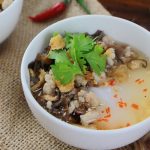Vietnamese salt preserved lemon (Chanh Muoi) is considered to be a long-standing recipe in cuisine of South Africa and India. Local people often use it as a kind of food to process salad meat and refreshing beverage. In Vietnam, salt preserved lemon is also used as cough, cold and digestive remedy.
The recipe of making salt preserved lemon is not too difficult; however, how to make lemon juice tasty, lemons’ color bright as well as not be bitter must follow certain principles. So now, Let’s explore how to make salt preserved lemons in this article.
Ingredients for making chanh muoi recipe:
- 2 kg lemons
- 600 g unrefined salt
- 1 tbsp rock sugar
- 50 g potassium alum
- 50 g licorice
- Glass jar (plastic jar should not be used)
Note about choosing lemons:
How to choose fresh lemons to make delicious salted lemon: choose ripe lemons, not young lemons. Choose medium lemons, not too big or too small. Lemon peel needs to be smooth, juicy and has natural yellow color. Should not choose the lemons with hard and rough peel because these ones often have little lime juice, are bitter and scum.
Instruction for making chanh muoi recipe:
Step 1:
Wash and scurb lemons and mix 100 g unrefined salt with water to make dilute salt water, soak lemons in about 1 hour to make lemons less sour and softer.
Step 2: Rub lemon peel
Put lemons into a pot with a little unrefined salt. Use hands to rub slightly lemon peel to get essential oil. Note while rubbing, remember to do gently to avoid lemons being crushed.
Rub the lemons until the color of lemon peel turns light and the salt getting green. This process will help lemon not to be black and mouldy when soaking
After all, Wash lemons clearly and drain out
Besides, you can use lemon zester tool sold in the supermarkets to save time for rubbing lemons and help lemons to be nicer.
Step 3:Puncture lemon peel
You can use sharp objects (toothpicks, large-sized sewing needles, fork head…) puncture around the lemon to help it absorb water better, juicy and not be shriveled, distorted after soaking. After puncturing, wash lemons a couple times with clean water and put into basket, drain out.
Step 4: Soak potassium alum
Boil 2,5 liters water and 50 g potassium alum until water boils, potassium alum dissolves completely. Let it cool down and put lemon into, use grid or a dish to keep lemons not floating and black. Soak lemons in potassium alum liquid one night, or at least 8 hours to make lemons white.
Step 5:
After soaking in potassium alum liquid, wash lemons clearly many times, then put into the basket, drain then place into pasteurized jar.
Boil 3l water with 250 g unrefined salt, when water boils and salt dissolves completely, take the foam out and turn off the stove. After saltwater is cool, pour it into lemon jar. Use chopsticks or grid to keep lemons not floating then put lemon jar under the sunshine, dry in 3 days.
Step 6:
After 3 days, take lemons out, use soft paper to absorb lemons gently to dry lemons completely then put them into another jar (do not wash lemons in cold water again). Pour out the saltwater that was soaked and do not reuse because the first saltwater contains a lot of lemon extract and sour water from lemons. If you reuse it, salted lemons will easily mold or be bitter.
Step 7:
Boil 3l water, 250g salt, 1 tbsp rock sugar and 50 g licorice, when water boils, take foam out and turn off the stove. After saltwater is cool completely, pour saltwater into lemon jar and put it in a cool place with much light to help salted lemon ripe quicker.
After 4-6 weeks, lemons will change from ivory white to dark yellow, salted lemon water is also darken and has a typical smell. Take a salted lemon out, use hand or chopsticks and squeeze gently to feel the lemon soft but stretch and well elastic. Then we can use it to mix with water or process other dishes.





![[Easy] Sinh to bo Recipe – Vietnamese avocado smoothie](../wp-content/uploads/2019/07/Sinh-to-bo-Recipe-Vietnamese-avocado-smoothie-1-150x150.jpg)

